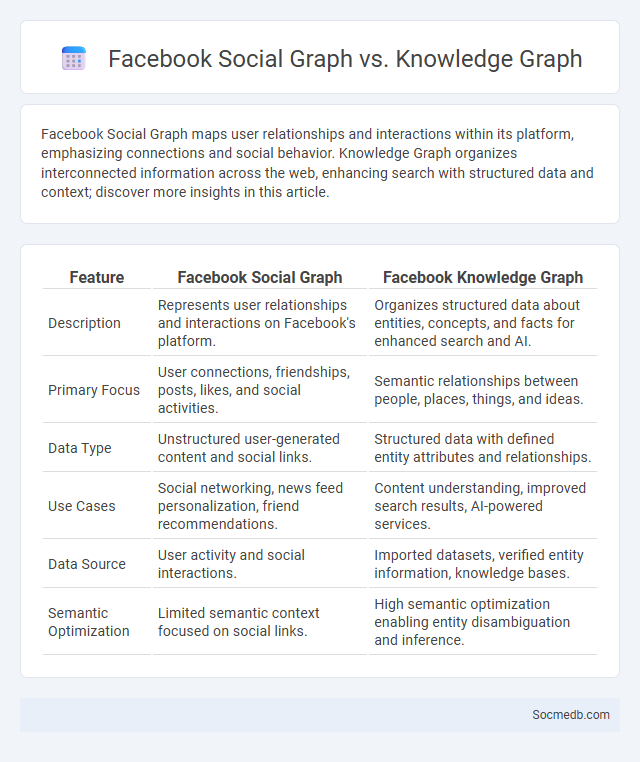
Photo illustration: Facebook Social Graph vs Knowledge Graph
Facebook Social Graph maps user relationships and interactions within its platform, emphasizing connections and social behavior. Knowledge Graph organizes interconnected information across the web, enhancing search with structured data and context; discover more insights in this article.
Table of Comparison
| Feature | Facebook Social Graph | Facebook Knowledge Graph |
|---|---|---|
| Description | Represents user relationships and interactions on Facebook's platform. | Organizes structured data about entities, concepts, and facts for enhanced search and AI. |
| Primary Focus | User connections, friendships, posts, likes, and social activities. | Semantic relationships between people, places, things, and ideas. |
| Data Type | Unstructured user-generated content and social links. | Structured data with defined entity attributes and relationships. |
| Use Cases | Social networking, news feed personalization, friend recommendations. | Content understanding, improved search results, AI-powered services. |
| Data Source | User activity and social interactions. | Imported datasets, verified entity information, knowledge bases. |
| Semantic Optimization | Limited semantic context focused on social links. | High semantic optimization enabling entity disambiguation and inference. |
Introduction to Graph Technologies in Social Media
Graph technologies revolutionize social media by modeling relationships between users, posts, and interactions as interconnected nodes and edges. This approach enables platforms to analyze complex networks, detect community structures, and personalize content through real-time data traversal. Utilizing graph databases like Neo4j enhances recommendation systems, friend suggestions, and fraud detection with scalable, relationship-focused data processing.
Understanding the Facebook Social Graph
The Facebook Social Graph maps connections between users, pages, groups, and interactions, enabling personalized content and targeted advertising. Understanding this graph helps you leverage relationships and data insights to optimize social media strategies for engagement and growth. By analyzing nodes and edges within the graph, your platform can enhance user experience and foster meaningful interactions.
What is a Knowledge Graph?
A Knowledge Graph is a structured database that connects entities such as people, places, and things through relationships, enhancing the way information is organized and retrieved on social media platforms. It enables more accurate content recommendations and improved search relevance by understanding the context behind your queries. Leveraging a Knowledge Graph can help your social media strategy by providing deeper insights into user interests and trending topics.
Defining the Social Graph: Broad Concepts
The social graph represents the network of connections between individuals, organizations, and entities on social media platforms, illustrating how relationships and interactions are structured and maintained. It encompasses nodes (users) and edges (relationships) that map out the dynamic flow of information and influence across digital communities. Understanding your social graph enables better targeting, content personalization, and enhanced engagement strategies in your social media efforts.
Key Differences: Facebook Social Graph vs General Social Graph
The Facebook Social Graph represents explicit, user-generated connections such as friendships, likes, and shares within the Facebook ecosystem, enabling personalized content and targeted advertising. In contrast, the General Social Graph aggregates implicit and explicit relationships across multiple platforms and offline interactions, capturing a broader and more diverse network structure. Understanding these differences is crucial for developers and marketers aiming to leverage social data for user engagement and behavior analysis.
Comparing Knowledge Graphs and Social Graphs
Knowledge graphs organize information by linking entities based on their contexts and relationships, enhancing semantic search and accurate data interpretation in social media platforms. Social graphs map the relationships and interactions between users, capturing social connections and behaviors to facilitate engagement and networking. Integrating knowledge graphs with social graphs improves content personalization and recommendation systems by combining user connection data with contextual knowledge.
Use Cases: Practical Applications in Business and Technology
Social media platforms drive customer engagement by enabling targeted advertising and personalized content, which enhance brand visibility and sales conversion rates. Businesses leverage social media analytics to monitor consumer sentiment, optimize marketing strategies, and predict market trends using AI-powered tools. In technology, social media APIs facilitate seamless integration with customer relationship management (CRM) systems, improving real-time communication and service delivery across multiple channels.
Privacy and Data Security Implications
Social media platforms collect vast amounts of personal data, making your privacy vulnerable to unauthorized access and potential misuse. Data breaches and targeted advertising algorithms raise significant concerns about how your sensitive information is stored and shared. Protecting your privacy involves understanding platform policies, adjusting privacy settings, and being cautious about the information you share online.
The Future of Graphs in Social Networking
Graphs are revolutionizing social networking by enhancing how platforms analyze and connect vast amounts of data to understand relationships and user behavior. Your social media experience will become more personalized and intuitive as graph technology enables real-time recommendations, improved content discovery, and stronger privacy measures. Leveraging graph analytics, social networks aim to foster deeper interactions and smarter connections that anticipate your needs and interests.
Conclusion: Choosing the Right Graph for Your Needs
Selecting the right graph for your social media data is crucial to accurately represent trends, engagement, and audience demographics. Your choice should align with the specific metrics you want to highlight, such as line graphs for tracking growth over time or pie charts to display distribution of user interactions. Understanding these visual tools ensures your social media analysis is clear, impactful, and tailored to your goals.
 socmedb.com
socmedb.com